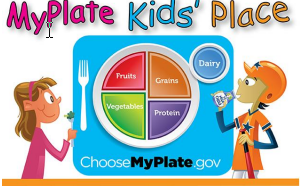10.3: Nutritional Needs
- Last updated
- Save as PDF
- Page ID
- 24654
A number of factors can influence children’s eating habits and attitudes toward food. Family environment, societal trends, taste preferences, and messages in the media all impact the emotions that children develop in relation to their diet. Television commercials can entice children to consume sugary products, fatty fast foods, excess calories, refined ingredients, and sodium. Therefore, it is critical that parents and caregivers direct children toward healthy choices. 5
Parents greatly impact their child’s nutritional choices. This time in a child’s life provides an opportunity for parents and other caregivers to reinforce good eating habits and to introduce new foods into the diet while remaining mindful of a child’s preferences. Parents should also serve as role models for their children, who will often mimic their behavior and eating habits. Parents must continue to help their school-aged child establish healthy eating habits and attitudes toward food. Their primary role is to bring a wide variety of health-promoting foods into the home so that their children can make good choices.6
Let’s think for a moment about what our parents and grandparents used to eat? What are some of the differences that you may have experienced as a child?
One hundred years ago, as families sat down to dinner, they might have eaten boiled potatoes or corn, leafy vegetables such as cabbage or collards, fresh-baked bread, and, if they were fortunate, a small amount of beef or chicken. Young and old alike benefitted from a sound diet that packed a real nutritional punch. Times have changed. Many families today fill their dinner plates with fatty foods, such as French Fries cooked in vegetable oil, a hamburger that contains several ounces of ground beef, and a white-bread bun, with a single piece of lettuce and a slice or two of tomato as the only vegetables served with the meal.

Our diet has changed drastically as processed foods, which did not exist a century ago, and animal-based foods now account for a large percentage of our calories. Not only has what we eat changed, but the amount of it that we consume has greatly increased as well, as plates and portion sizes have grown much larger. All of these choices impact our health, with short- and long-term consequences as we age. Possible effects in the short-term include excess weight gain and constipation. The possible long-term effects, primarily related to obesity, include the risk of cardiovascular disease, diabetes, hypertension, as well as other health and emotional problems for children. Centers for Disease Control and Prevention. “Overweight and Obesity: Health Consequences.”8
During middle childhood, a healthy diet facilitates physical and mental development and helps to maintain health and wellness. School-aged children experience steady, consistent growth, but at a slower rate than they did in early childhood. This slowed growth rate can have to last a lasting impact if nutritional, caloric, and activity levels aren't adjusted in middle childhood which can lead to excessive weight gain early in life and can lead to obesity into adolescence and adulthood.9
Making sure that children have proper nutrients will allow for optimal growth and development. Look at the figure below to familiarize yourself with food and the place setting for healthy meals.

One way to encourage children to eat healthy foods is to make meal and snack time fun and interesting. Parents should include children in food planning and preparation, for example selecting items while grocery shopping or helping to prepare part of a meal, such as making a salad. At this time, parents can also educate children about kitchen safety. It might be helpful to cut sandwiches, meats, or pancakes into small or interesting shapes. In addition, parents should offer nutritious desserts, such as fresh fruits, instead of calorie-laden cookies, cakes, salty snacks, and ice cream. Studies show that children who eat family meals on a frequent basis consume more nutritious foods.11
Energy
Children’s energy needs vary, depending on their growth and level of physical activity. Energy requirements also vary according to gender. Girls require 1,200 to 1,400 calories a day from age 2 to 8 and 1,400-1,800 for age 9 to 13. Boys also need 1,200 to 1.400 calories daily from ages 4 to 8 but their daily caloric needs go up to 1,600-2,000 from ages 9 to 13. This range represents individual differences, including how active the child is.12
Recommended intakes of macronutrients (protein, carbohydrates, and fats) and most micronutrients (vitamins and minerals) are higher relative to body size, compared with nutrient needs during adulthood. Therefore, children should be provided nutrient-dense food at meal-and snack-time. However, it is important not to overfeed children, as this can lead to childhood obesity, which is discussed in the next section.
Children and Vegetarianism
Another issue that some parents face with school-aged children is the decision to encourage a child to become a vegetarian or a vegan. Some parents and caregivers decide to raise their children as vegetarians for health, cultural, or other reasons. Preteens and teens may make the choice to pursue vegetarianism on their own, due to concerns about animals or the environment. No matter the reason, parents with vegetarian children must take care to ensure vegetarian children get healthy, nutritious foods that provide all the necessary nutrients.
Types of Vegetarian Diets
There are several types of vegetarians, each with certain restrictions in terms of diet:
- Ovo-vegetarians. Ovo-vegetarians eat eggs but do not eat any other animal products.
- acto-ovo-vegetarians. Lacto-ovo-vegetarians eat eggs and dairy products but do not eat any meat.
- Lacto-vegetarians. Lacto-vegetarians eat dairy products but do not eat any other animal products.
- Vegans. Vegans eat food only from plant sources, no animal products at all.

Children who consume some animal products, such as eggs, cheese, or other forms of dairy, can meet their nutritional needs. For a child following a strict vegan diet, planning is needed to ensure adequate intake of protein, iron, calcium, vitamin B12, and vitamin D. Legumes and nuts can be eaten in place of meat, soy or almond milk fortified with calcium and vitamins D and B12 can replace cow’s milk. Parents must be informed and knowledgeable in order to support proper development for children with a vegetarian or vegan diet.14
Children and Malnutrition
Many may not know that malnutrition is a problem that many children face, in both developing nations and the developed world. Even with the wealth of food in North America, many children grow up malnourished, or even hungry. The US Census Bureau characterizes households into the following groups:
- food secure
- food insecure without hunger
- food insecure with moderate hunger
- food insecure with severe hunger
Millions of children grow up in food-insecure households with inadequate diets due to both the amount of available food and the quality of food. In the United States, about 20 percent of households with children are food insecure to some degree. In half of those, only adults experience food insecurity, while in the other half both adults and children are considered to be food insecure, which means that children did not have access to adequate, nutritious meals at times.15
Growing up in a food-insecure household can lead to a number of problems. Deficiencies in iron, zinc, protein, and vitamin A can result in stunted growth, illness, and limited development. Federal programs, such as the National School Lunch Program, the School Breakfast Program, and Summer Feeding Programs, work to address the risk of hunger and malnutrition in school-aged children. They help to fill the gaps and provide children living in food-insecure households with greater access to nutritious meals.16
School Lunch Programs 17
Many school-age children eat breakfast, snacks, and lunch at their schools. Therefore, it is important for schools to provide meals that are nutritionally sound. In the United States, more than thirty-one million children from low-income families are given meals provided by the National School Lunch Program. This federally funded program offers low-cost or free breakfast, snacks, and lunches to school facilities. School districts that take part receive subsidies from the US Department of Agriculture (USDA) for every meal they serve that must meet the 2015 Dietary Guidelines for Americans.
Knowing that many children in the United States buy or receive free lunches in the school cafeteria, it might be worthwhile to look at the nutritional content of school lunches. You can obtain this information through your local school district’s website. An example of a school menu from a school district in north-central Texas is a meal consisting of pasta alfredo, breadstick, peach cup, tomato soup, a brownie, and 2% milk which is in compliance with Federal Nutritional Guidelines. Consider another menu from an elementary school in the state of Washington. This sample meal consists of chicken burger, tater tots, fruit, veggies, and 1% or nonfat milk. This meal is also in compliance with Federal Nutrition Guidelines but has about 300 fewer calories than the menu in Texas. This is a big difference in calories and nutritional value of these prepared lunches that are chosen and approved by officials on behalf of children in these districts.

Healthy School Lunch Campaigns helps to promote children’s health. This is done by educating government officials, school officials, food-service workers, and parents and is sponsored by the Physicians Committee for Responsible Medicine. They educate and encourage schools to offer low-fat, cholesterol-free options in school cafeterias and in vending machines and work to improve the food served to children at school. Unfortunately, many school districts in the nation allow students to purchase chips, cookies, and ice cream along with their meals. These districts rely on the sale of these items in the lunchrooms to earn additional revenues. Not only are they making money off of children and families with junk food, but they are also adding additional empty calories to their daily intake. These districts need to look at the menus and determine the rationale for offering additional snacks and desserts for children at their schools. Whether children receive free lunches, buy their own, or bring their lunch from home, quality nutrition is what is best for these growing bodies and minds.
Food Allergies and Food Intolerance
Food intolerance and food allergies are an issue for some school-aged children. Recent studies show that three million children under age eighteen are allergic to at least one type of food. Some of the most common food allergies come from foods that include peanuts, milk, eggs, soy, wheat, and shellfish. An allergy occurs when a protein in food triggers an immune response, which results in the release of antibodies, histamine, and other defenders that attack foreign bodies. Possible symptoms include itchy skin, hives, abdominal pain, vomiting, diarrhea, and nausea. Symptoms usually develop within minutes to hours after consuming a food allergen. Children can outgrow a food allergy, especially allergies to wheat, milk, eggs, or soy.19
Anaphylaxis is a life-threatening reaction that results in difficulty breathing, swelling in the mouth and throat, decreased blood pressure, shock, or even death. Milk, eggs, wheat, soybeans, fish, shellfish, peanuts, and tree nuts are the most likely to trigger this type of response. A dose of the drug epinephrine is often administered via a “pen” to treat a person who goes into anaphylactic shock.20

Some children experience a food intolerance, which does not involve an immune response. A food intolerance is marked by unpleasant symptoms that occur after consuming certain foods. Lactose intolerance, though rare in very young children, is one example. Children who suffer from this condition experience an adverse reaction to the lactose in milk products. It is a result of the small intestine’s inability to produce enough of the enzyme lactase. Symptoms of lactose intolerance usually affect the gastrointestinal tract and can include bloating, abdominal pain, gas, nausea, and diarrhea. An intolerance is best managed by making dietary changes and avoiding any foods that trigger the reaction.22
Being Overweight and Obesity in Children
Excess weight and obesity in children are associated with a variety of medical conditions including high blood pressure, insulin resistance, inflammation, depression, and lower academic achievement (Lu, 2016). Being overweight has also been linked to impaired brain functioning, which includes deficits in executive functioning, working memory, mental flexibility, and decision making (Liang, Matheson, Kaye, & Boutelle, 2014). Children who ate more saturated fats performed worse on relational memory tasks while eating a diet high in omega-3 fatty acids promoted relational memory skills (Davidson, 2014). Using animal studies, Davidson et al. (2013) found that large amounts of processed sugars and saturated fat weakened the blood-brain barrier, especially in the hippocampus. This can make the brain more vulnerable to harmful substances that can impair its functioning. Another important executive functioning skill is controlling impulses and delaying gratification. Children who are overweight show less inhibitory control than normal-weight children, which may make it more difficult for them to avoid unhealthy foods (Lu, 2016). Overall, being overweight as a child increases the risk of cognitive decline as one age.

The current measurement for determining excess weight is the Body Mass Index (BMI) which expresses the relationship of height to weight. According to the Centers for Disease Control and Prevention (CDC), childrens whose BMI is at or above the 85th percentile for their age are considered overweight, while children who are at or above the 95th percentile are considered obese (Lu, 2016). In 2011-2012 approximately 8.4% of 2-5 year-olds were considered overweight or obese, and 17.7% of 6-11 year-olds were overweight or obese (CDC, 2014b).24
Obesity Rates for Children: About 16 to 33 percent of American children are obese (U. S. Department of Health and Human Services, 2005). This is defined as being at least 20 percent over their ideal weight. The percentage of obesity in school-aged children has increased substantially since the 1960s and has in fact doubled since the 1980s. This is true in part because of the introduction of a steady diet of television and other sedentary activities. In addition, we have come to emphasize high fat, fast foods as a culture. Pizza, hamburgers, chicken nuggets and “lunchables” with soda have replaced more nutritious foods as staples. The decreased participation in school physical education and youth sports is just one of many factors that have led to an increase in children being overweight or obese.
Being Overweight Can Be a Lifelong Struggle
A growing concern is the lack of recognition from parents that children are overweight or obese. Katz (2015) referred to this as “oblivobesity”. Black et al. (2015) found that parents in the United Kingdom (UK) only recognized their children as obese when they were above the 99.7th percentile while the official cut-off for obesity is at the 85th percentile. Oude Luttikhuis, Stolk, and Sauer (2010) surveyed 439 parents and found that 75% of parents of overweight children said the child had a normal weight and 50% of parents of obese children said the child had a normal weight. For these parents, overweight was considered normal and obesity was considered normal or a little heavy. Doolen, Alpert, and Miller (2009) reported on several studies from the United Kingdom, Australia, Italy, and the United States, and in all locations, parents were more likely to misperceive their children’s weight. Black, Park, and Gregson (2015) concluded that as the average weight of children rises, what parents consider normal also rises. If parents cannot identify if their children are overweight they will not be able to intervene and assist their children with proper weight management.
An added concern is that the children themselves are not accurately identifying if they are overweight. In a United States sample of 8-15 year-olds, more than 80% of overweight boys and 70% of overweight girls misperceived their weight as normal (Sarafrazi, Hughes, & Borrud, 2014). Also noted was that as the socioeconomic status of the children rose, the frequency of these misconceptions decreased. It appeared that families with more resources were more conscious of what defines a healthy weight.
Results of Childhood Obesity
Children who are overweight tend to be rejected, ridiculed, teased and bullied by others (Stopbullying.gov, 2016). This can certainly be damaging to their self-image and popularity. In addition, obese children run the risk of suffering orthopedic problems such as knee injuries, and they have an increased risk of heart disease and stroke in adulthood (Lu, 2016). It is hard for a child who is obese to become a non-obese adult. In addition, the number of cases of pediatric diabetes has risen dramatically in recent years.
Behavioral interventions, including training children to overcome impulsive behavior, are being researched to help overweight children (Lu, 2016). Practicing inhibition has been shown to strengthen the ability to resist unhealthy foods. Parents can help their overweight children the best when they are warm and supportive without using shame or guilt. They can also act like the child’s frontal lobe until it is developed by helping them make correct food choices and praising their efforts (Liang, et al., 2014). Research also shows that exercise, especially aerobic exercise, can help improve cognitive functioning in overweight children (Lu, 2016). Parents should take caution against emphasizing diet alone to avoid the development of any obsession about dieting that can lead to eating disorders. Instead, increasing a child's activity level is most helpful.
Dieting is not really the answer. If you diet, your basal metabolic rate tends to decrease thereby making the body burn even fewer calories in order to maintain the weight. Increased activity is much more effective in lowering weight and improving the child’s health and psychological well-being. Exercise reduces stress and being an overweight child, subjected to the ridicule of others can certainly be stressful. Parents should take caution against emphasizing diet alone to avoid the development of any obsession about dieting that can lead to eating disorders as teens. Again, helping children to make healthy food choices and increasing physical activity will help prevent childhood obesity.25
Contributors and Attributions
5. Research on the Benefits of Family Meals. Dakota County, Minnesota. . Updated April 30, 2012. Accessed December 4, 2017.
6. Childhood by University of Hawai’i at Mānoa Food Science and Human Nutrition Program is licensed under CC BY-NC-SA 4.0
8. An Introduction to Nutrition by Maureen Zimmerman and Beth Snow is licensed under CC BY-NC-SA 3.0
9. Childhood by University of Hawai’i at Mānoa Food Science and Human Nutrition Program is licensed under CC BY-NC-SA 4.0 (modified by Dawn Rymond)
11. Research on the Benefits of Family Meals. Dakota County, Minnesota. . Updated April 30, 2012. Accessed December 4, 2017.
12. Parent Tips – Calories Needed Each Day by the NIH is in the public domain
14. An Introduction to Nutrition by Maureen Zimmerman and Beth Snow is licensed under CC BY-NC-SA 3.0
15. Coleman-Jensen A, et al. Household Food Security in the United States in 2010. US Department of Agriculture, Economic Research Report, no. ERR-125; 2011.
16. Lifespan Development - Module 6: Middle Childhood by Lumen Learning references Psyc 200 Lifespan Psychology by Laura Overstreet, licensed under CC BY 4.0 (modified by Dawn Rymond) Childhood by University of Hawai’i at Mānoa Food Science and Human Nutrition Program is licensed under CC BY-NC-SA 4.0 (modified by Dawn Rymond)
17. Lifespan Development - Module 6: Middle Childhood by Lumen Learning references Psyc 200 Lifespan Psychology by Laura Overstreet, licensed under CC BY 4.0 (modified by Dawn Rymond) Childhood by University of Hawai’i at Mānoa Food Science and Human Nutrition Program is licensed under CC BY-NC-SA 4.0 (modified by Dawn Rymond)
19. Childhood by University of Hawai’i at Mānoa Food Science and Human Nutrition Program is licensed under CC BY-NC-SA 4.0
20. Food Allergy Quick Facts. National Institutes of Health, US Department of Health and Human Services. Updated March 27, 2017. Accessed December 10, 2017.
Childhood by University of Hawai’i at Mānoa Food Science and Human Nutrition Program is licensed under CC BY-NC-SA 4.0
22. Lactose Intolerance. National Institute of Diabetes and Digestive and Kidney Diseases. Updated June 2014. Accessed December 4, 2017.; Childhood by University of Hawai’i at Mānoa Food Science and Human Nutrition Program is licensed under CC BY-NC-SA 4.0
24. Lifespan Development: A Psychological Perspective by Martha Lally and Suzanne Valentine-French is licensed under CC BY-NC-SA 3.0
25. Lifespan Development: A Psychological Perspective by Martha Lally and Suzanne Valentine-French is licensed under CC BY-NC-SA 3.0 (modified by Dawn Rymond); Lifespan Development - Module 6: Middle Childhood by Lumen Learning references Psyc 200 Lifespan Psychology by Laura Overstreet, licensed under CC BY 4.0 (modified by Dawn Rymond)


